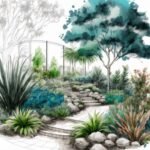Multifunctionality and Space Saving
- By -Peter
- Posted on
- Posted in Modern Architecture
Multifunctional design solutions are revolutionizing how living spaces are optimized for efficiency and versatility. This article explores strategies, benefits, and examples of integrating multifunctionality to maximize space utilization effectively.

Strategies for Multifunctional Design
Flexible Furniture and Storage Solutions
Modular furniture, such as sofa beds, folding tables, and expandable shelving units, adapt to varying needs and spatial configurations. Integrated storage compartments maximize vertical space and reduce clutter in compact environments.
Open-Plan Layouts and Zoning Techniques
Open-plan designs and flexible zoning strategies define functional areas without enclosing spaces. Room dividers, sliding partitions, and movable screens create versatile environments that accommodate diverse activities and privacy preferences.
Benefits of Multifunctional Living Spaces
Space Optimization and Efficiency
Maximizing floor area through versatile furniture and spatial planning enhances usability without compromising comfort. Multifunctional designs accommodate changing lifestyles, evolving family dynamics, and spatial constraints.
Improved Quality of Life and Comfort
Enhanced functionality promotes a sense of organization and orderliness in living environments. Streamlined layouts and ergonomic solutions enhance comfort, productivity, and overall well-being for residents.
Examples of Multifunctional Design Solutions
- IKEA’s GRÖNLID Sofa SeriesThe GRÖNLID sofa series features modular components and built-in storage options, transforming seating arrangements into guest beds and additional storage spaces in small apartments.
- Transformer Apartment, Hong KongInnovative apartments in Hong Kong feature adaptable spaces with movable walls, foldable furniture, and concealed storage units, optimizing limited square footage for various uses.
Innovative Approaches to Space Saving
Vertical and Underutilized Spaces
Utilizing vertical surfaces for storage, shelving, and hanging gardens maximizes floor space. Overhead storage racks, wall-mounted desks, and compact kitchen modules optimize efficiency in smaller dwellings.
Integrated Technology and Smart Solutions
Smart home technologies automate functions and optimize space usage. IoT-enabled devices, such as smart lighting systems and voice-activated assistants, enhance convenience and energy efficiency in multifunctional environments.
Challenges in Implementing Multifunctional Design
Design Complexity and Aesthetic Integration
Balancing functionality with aesthetic appeal requires thoughtful design integration and cohesive visual harmony. Seamless transitions between functional zones and material choices contribute to cohesive living environments.
User Adaptability and Ergonomics
Ensuring user comfort and adaptability to multifunctional spaces involves ergonomic considerations and user-centered design principles. Accessibility, ease of use, and intuitive layouts enhance usability and satisfaction.
Future Trends: Innovations in Multifunctional Living
Sustainable Design Practices
Embracing sustainability through eco-friendly materials, modular construction, and energy-efficient solutions promotes environmental stewardship in multifunctional living spaces.
Responsive Architecture and Adaptability
Advancements in adaptable architecture and responsive design technologies anticipate future needs and lifestyle changes. Flexible living environments evolve with user preferences, technological advancements, and urban trends.
Conclusion: Creating Efficient and Versatile Living Environments
Multifunctionality and space-saving solutions redefine contemporary living by optimizing spatial efficiency, enhancing functionality, and promoting sustainable practices. By integrating versatile design strategies, homeowners embrace adaptable lifestyles and maximize the potential of their living spaces.
Takeaways: Key Insights
- Multifunctional design solutions optimize space efficiency and usability.
- Innovative approaches include flexible furniture, open-plan layouts, and smart technologies.
- Future trends emphasize sustainability, adaptability, and user-centered design in multifunctional living environments.
By embracing multifunctionality and space-saving strategies, homeowners and designers unlock creative possibilities for efficient, adaptable, and enjoyable living spaces that cater to diverse lifestyles and evolving needs.



